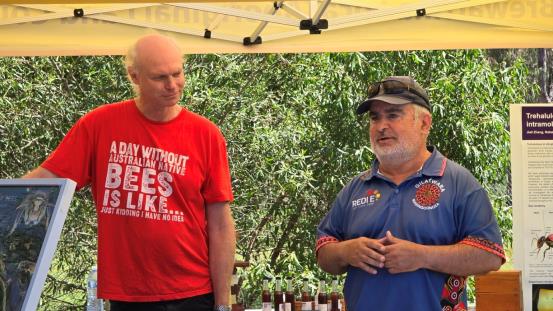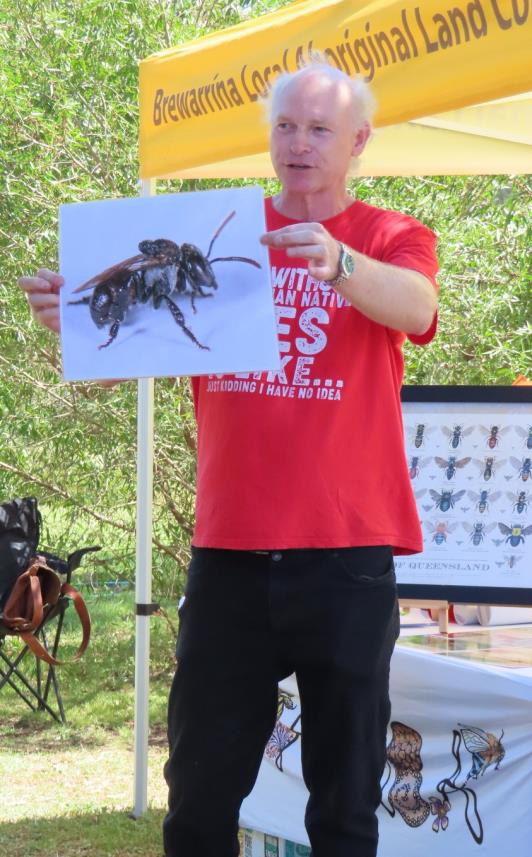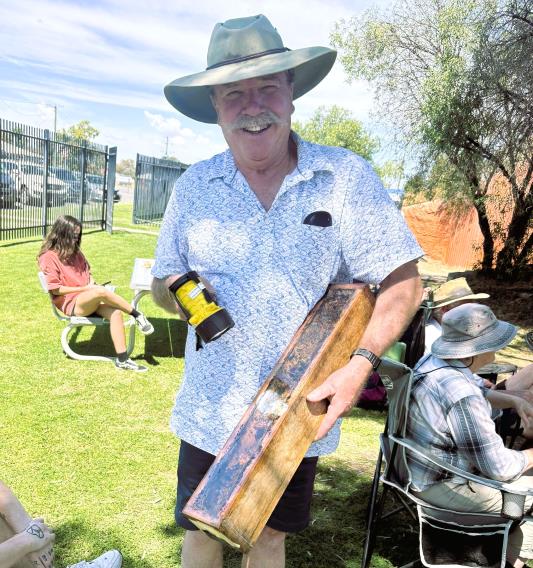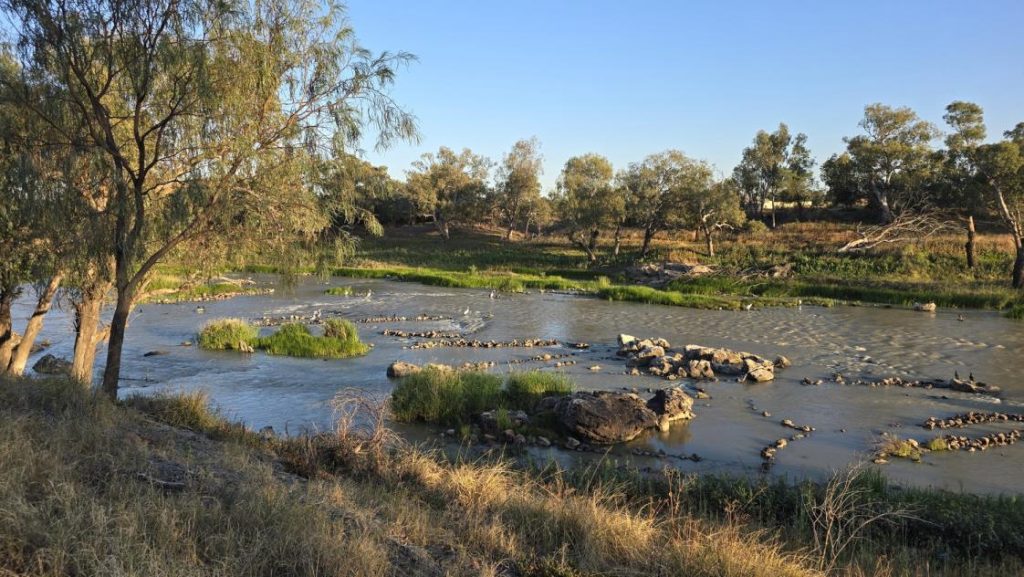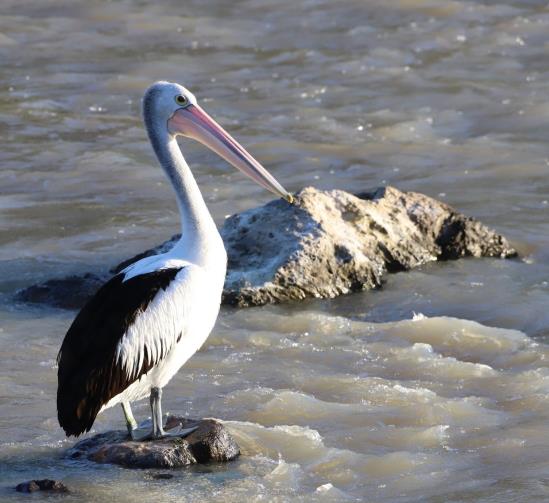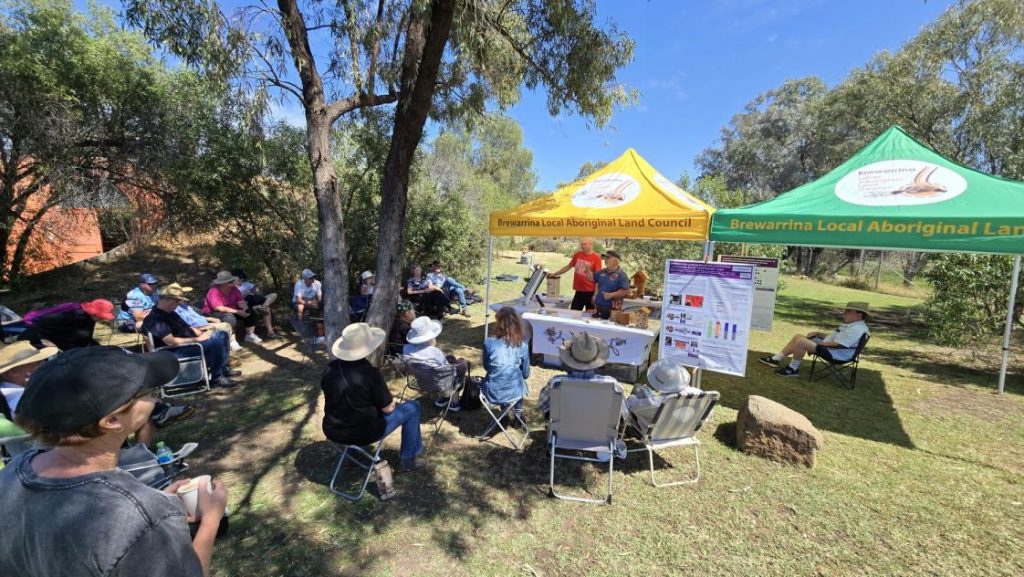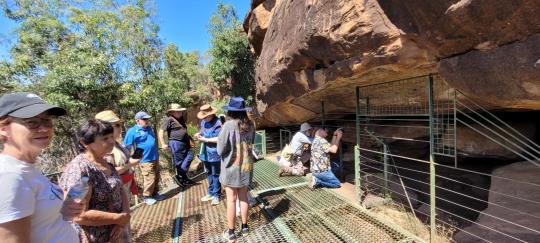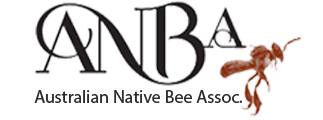Steve Brownlie and I (Dean) teamed up with Brad Steadman to present a native bee workshop and Aboriginal cultural activities on the October long weekend. This occurred in Brewarrina, which is a small, far western NSW town not that far from the QLD border. It’s where I first learned about stingless bees when a boy, with Mum’s uncles describing australis nests, and how new colonies were made. Interest in native bees is contagious. Many years later, cousin Brad became interested in our australis bees after reading my book and talking to me and uncle. He started to ask some of our old people for traditional (some call them dreamtime) stories about our bees, and soon discovered how they fit into culture and medicine. After a while, cousin Brad started teaching about bees and honey to some of the towns schoolkids. I donated logs with australis bees to the local Aboriginal cultural museum, with signage to teach locals and visitors about their importance. Since those logs were installed, Brad has learned a lot about their interaction with local plant species including bush tucker, and bush medicine plants. Curiosity is growing to see how medicinal this honey could be. We planned the native bee workshop to focus mostly on the naturally occurring australis bees, while providing some introduction and background to other Australian native bees. My hope was to attract locals from western and far western NSW, as well as providing an opportunity for more eastern living ANBA members to visit. The event attracted 30 people from Brisbane, Sydney, Brewarrina, Scone, Wilcannia, Nyngan, Gulgong, Newcastle, Batemans Bay, Gunnedah, and Blackbutt. Brad was keen to leverage some of the towns other attractions and we put together a unique program over two days that offered far more than bees. We hope that showcasing these amazing attractions will attract more tourists over time.
We had fun, told stories and socialised at the local Chinese restaurant. People looked at birds and plants, camped by the river, and visited National Parks and other towns on their way home after our event. I got to see some family, talk about bees, and hang out with some
great people. Thank you.
Bird Watching
Although the country around Brewarrina can appear quite dry, a birds eye perspective shows that it is surrounded by rivers, creeks, and wetlands including Narran Lakes and Macquarie Marshes. The result in a stunning variety of birds. From tiny finches and dessert budgerigar to fishing eagles and Pelican. I saw thousands of cute baby Emu’s covered in stripes, and Brisbane branch member Lynda Litz counted 61 birds in 2 days. Lynda told me that the regions bird numbers could be promoted to attract bird watchers.
Brewarrina Aboriginal Mission Tour
The Brewarrina Aboriginal Mission was the largest and longest running institutional-type community in NSW. It operated from 1886 – 1965 and was managed by the Aboriginal Welfare/Protection Board. The Brewarrina mission is part of wider Aboriginal history, as people from many parts of NSW were relocated here to separate them from family and land. Sadly, the plan was to assimilate the Aboriginal people by removing their cultural ties. The mission serves as a stark reminder of previous governments policies, and all that remains there now are graves.
Fish Trap Tour
Archaeologists estimate the Ngunnhu to be over 40,000 years old, and they continue to have a strong social, cultural and spiritual association for Aboriginal people with connections to the area. Aboriginal legend explains that the fish traps are an ancient Dreamtime site built by the ancestral creator, Baiame, and his two sons Boomaoomaowi and Ghindaindamui. Baiame came up with the design by throwing his net over the river and, with the help of his two sons, built the fish traps to their current shape. The intricate design of the dry-stone rock weirs and pens stretches for around half a kilometre, to catch fish as they swam upstream. The design also allowed the fish traps to resist damage during both high and low river flows.
Full day Bee Workshop
The native bee workshop included talks from Dean Haley, Mary Fletcher, and Brad Steadman. Demonstrations included honey harvesting, splitting, and bee keeping techniques. Bees were transferred from a log into a box and participants were able to see the natural way that bees design their nest. Honey was eaten with fresh hot damper. Morning tea and lunch were provided. A key aim of the workshop was to provide in depth knowledge of key bee husbandry techniques to locals. Treating bees gently and treating them as family members fits in with Aboriginal knowledge, as well as stingless bee keeper ethics. We were speaking the same language. TrueBlue Bees donated framed bee posters and kids books (Lovely, by Melissa Ballantyne) to the local school.
Excursion to Mount Gundabooka Cave Paintings
The Gundabooka Range is a significant place for the Ngemba People with many ceremonial gatherings taking place and a history of rock art present. The range was once a vital resource in dry periods with the creeks being one of the few locations to offer water during droughts. The mountain and nearby Yanda Creek were used as a part of an extensive travel network that linked the mountain with other waterholes, creeks and the Darling River. Artwork includes dancers, hand stencils, and pictures of fish, Emu, and Dingo. The Brewarrina Local Aboriginal Land Council provided bus and driver for this excursion, and Brad Steadman provided Indigenous context and names for the rock paintings, flora, fauna, and location. This is a special place.
Sponsors and Participants
Brad Steadman – Local historian, cultural knowledge keeper, and language expert. Key organiser
Bradley Hardy – Museum and Fish traps tour guide
Dean Haley & Steve Brownlie – Native bee keepers, bee workshop presenters
Professor Mary Fletcher – Guest presenter
Urayne Waraweena – LALC CEO/ Bus Driver
Brewarrina Aboriginal Cultural Museum – Location for bee workshop
Brewarrina Local Aboriginal Lands Council – Gazebos, bus to Mission and Mt Gundabooka
REDI-E – Rural Enterprise Development Institute – Catering from Brad’s employer
TrueBlue Bees – Provided bee workshop. Co-organiser
Wide Bay Stingless Bees – Donations of logs and honey
ANBA – Promotion in Cross pollinator and loan of display materials. If this event is to occur again, financial ANBA sponsorship will be needed
Mary Fletcher and Ed Parker – Photographs
